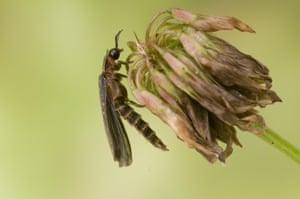In the hedgerows the blackthorn is shooting sprays of small white blossom upwards, thus signalling the end of the winter. If this is so, then we have had an exceptionally warm and wet season. Perhaps counter-intuitively, such weather can spell disaster for many insects; adapted as they are to sitting out a season, their biggest enemies become mould and bacteria that may proliferate in their dormant tissues. Concern turns to the potential impact on already struggling populations of insects that have faced so many challenges in recent times, most blatantly the fragmentation and pollution of their habitats. We must firmly add climate change to this list, the most recent evidence coming from a long-term study of glow-worm populations in Essex that found an overall fall of 75% in their numbers on 19 sites.
Glow-worms are enigmatic and intriguing animals at every level. I can recall camping near Hastings as a child and seeing one glowing in the vegetation, but on investigating the mysterious light blinked out and the source could not be discovered. The larvae and the wingless female, Lampyris noctiluca, are brown segmented animals, not as instantly recognisable as beetles; they feast on snails and possess a white spongy appendage that extrudes from their rear-end and wipes snail slime from their body. The eyes of the adult male beetle are also fantastic: two great hooded orbs, aerial searchers for the cool, green lights of the females.

“Bright scatter’d, twinkling star of spangled earth,” the Northamptonshire poet John Clare wrote of them in 1820, “Thy pale-fac’d glimmering light I love to see.” But everyone who is anyone has written about glow-worms; they are in A Midsummer Night’s Dream and Blake’s A Dream, as well as Wordsworth, Coleridge, Pliny, Dr Johnson and William Cowper. “We are all worms,” Churchill stated, “but I do believe that I am a glow-worm.”
Like coral reefs, glow-worms must now go on to the “last chance to see” list. There are still places in Northamptonshire and farther afield where they can be found, and perhaps this June we should go and see them, while we can.